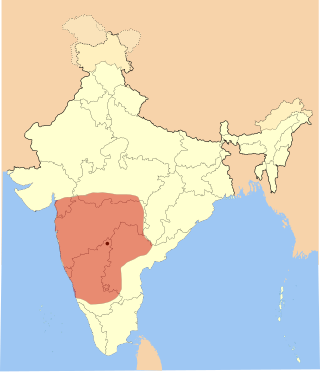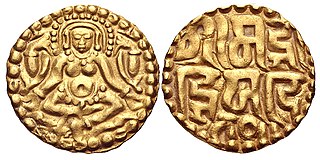
The middle kingdoms of India were the political entities in the Indian subcontinent from 230 BCE to 1206 CE. The period begins after the decline of the Maurya Empire and the corresponding rise of the Satavahana dynasty, starting with Simuka, from 230 BCE. The "middle" period lasted for almost 1436 years and ended in 1206 CE, with the rise of the Delhi Sultanate, founded in 1206, and the end of the Later Cholas.

Basava (1131–1196), also called Basavēśvara and Basavaṇṇa, was an Indian philosopher, poet, Lingayat social reformer in the Shiva-focused bhakti movement, and a Hindu Shaivite social reformer during the reign of the Kalyani Chalukya/Kalachuri dynasty. Basava was active during the rule of both dynasties but reached the peak of his influence during the rule of King Bijjala II in Karnataka, India.

Davanagere district is an administrative district of Karnataka state in India. It is the centre of Karnataka. The city of Davanagere is the district headquarters. It had a population of 1,643,494 of which 32.31% was urban as of 2011. This district was separated from Chitradurga district in 1997 by the then Chief minister of Karnataka J. H. Patel including Chennagiri and Honali Taluks Shimoga district.

The Western Chalukya Empire ruled most of the western Deccan, South India, between the 10th and 12th centuries. This Kannada dynasty is sometimes called the Kalyani Chalukya after its regal capital at Kalyani, today's Basavakalyan in the modern Bidar District of Karnataka state, and alternatively the Later Chalukya from its theoretical relationship to the 6th-century Chalukya dynasty of Badami. The dynasty is called Western Chalukyas to differentiate from the contemporaneous Eastern Chalukyas of Vengi, a separate dynasty. Prior to the rise of these Chalukyas, the Rashtrakuta empire of Manyakheta controlled most of Deccan and Central India for over two centuries. In 973, seeing confusion in the Rashtrakuta empire after a successful invasion of their capital by the ruler of the Paramara dynasty of Malwa, Tailapa II, a feudatory of the Rashtrakuta dynasty ruling from Bijapur region defeated his overlords and made Manyakheta his capital. The dynasty quickly rose to power and grew into an empire under Someshvara I who moved the capital to Kalyani.

Bijjala II Kannada: ಇಮ್ಮಡಿ ಬಿಜ್ಜಳ was the Mahamandaleshwara of the Kalyani Chalukyas. He was the most famous of the southern Kalachuri kings who ruled initially as a vassal of Chalukya Vikramaditya VI. He ruled as the Mahamandalesvara over Karhada-4000 and Tardavadi-1000 provinces, designations given to territories within the larger Western Chalukya kingdom.

Basavakalyana is a historical city and municipal council in the Bidar District of the Indian state of Karnataka. It was the capital of two dynasties — Kalyani Chalukya and Kalachuris of Kalyani. It is famous for the world's tallest Basavanna statue, which stands 108 feet high. It is one of the major cities and industrial hubs of Bidar district.

The Seuna, Sevuna, or Yadavas of Devagiri was a medieval Indian dynasty, which at its peak ruled a realm stretching from the Narmada river in the north to the Tungabhadra river in the south, in the western part of the Deccan region. Its territory included present-day Maharashtra, northern Karnataka and parts of Madhya Pradesh, from its capital at Devagiri.
Narasimha I was a ruler of the Hoysala Empire. His victory over his overlord Western Chalukya Empire King Tailapa III paved the way for the declaration of independence by his successor, and is his main legacy. Tailapa III was killed by Narasimha I. He however failed to meet the challenge of their Kalachuri feudatory Bijjala II. Narasimha I was overthrown by his son Veera Ballala II.

Veera Ballala II was the most notable monarch of the Hoysala Empire. His successes against the Yadavas of Devagiri, the Southern Kalachuris, the Pandyas of Madurai and the waning Western Chalukya Empire, and his domination over the diminishing Cholas of Tanjore took the Hoysalas to their peak of power. The historian Chaurasia claims by the end of the 12th century, Ballala II's conquests had made the Hoysalas the most powerful dynasty of the Deccan. According to historian Derrett, Ballala II was "the most outstanding among Hoysala kings", and historian William Coelho in comparing Ballala II to King Vishnuvardhana writes, "he vied in glory with his grandfather".
Tailapa III succeeded Jagadhekamalla II to the Western Chalukya throne. His rule saw the beginning of the end of the Chalukya empire. Kakatiya dynasty's Prola II warred with him, defeated and took the Chalukya king captive. This resulted in other feudatories rising against the Chalukyas. The Seuna and the Hoysala started to take away territory. Kalachuri Bijjala II captured the regal capital Kalyani in 1157 when Tailapa III had to flee to Annigeri. Finally Tailapa III was killed by Hoysala Vira Narasimha in 1162.
Jagadhekamalla III succeeded Tailapa III to the highly diminished Western Chalukya empire. His rule was completely overshowded by the emergence of the Southern Kalachuris under Bijjala II who took control of Basavakalyana and ruled from there. He found refuge in the Banavasi region of the Western ghats, while Bijjala his former vassal became suzerain at Kalyana in 1162. The king in exile was a contemporary of Basavanna and other noted Veerashaiva preceptors.

A large body of Western Chalukya literature in the Kannada language was produced during the reign of the Western Chalukya Empire in what is now southern India. This dynasty, which ruled most of the western Deccan in South India, is sometimes called the Kalyani Chalukya dynasty after its royal capital at Kalyani, and sometimes called the Later Chalukya dynasty for its theoretical relationship to the 6th-century Chalukya dynasty of Badami. For a brief period (1162–1183), the Kalachuris of Kalyani, a dynasty of kings who had earlier migrated to the Karnataka region from central India and served as vassals for several generations, exploited the growing weakness of their overlords and annexed the Kalyani. Around 1183, the last Chalukya scion, Someshvara IV, overthrew the Kalachuris to regain control of the royal city. But his efforts were in vain, as other prominent Chalukya vassals in the Deccan, the Hoysalas, the Kakatiyas and the Seunas destroyed the remnants of the Chalukya power.
Medieval Kannada literature covered a wide range of subjects and genres which can broadly be classified under the Jain, Virashaiva, Vaishnava and secular traditions. These include writings from the 7th century rise of the Badami Chalukya empire to the 16th century, coinciding with the decline of Vijayanagara Empire. The earliest known literary works until about the 12th century CE were mostly authored by the Jainas along with a few works by Virashaivas and Brahmins and hence this period is called the age of Jain literature,. The 13th century CE, to the 15th century CE, saw the emergence of numerous Virashaiva and Brahminical writers with a proportional decline in Jain literary works. Thereafter, Virashaiva and Brahmin writers have dominated the Kannada literary tradition. Some of the earliest metres used by Jain writers prior to 9th century include the chattana, bedande and the melvadu metres, writings in which have not been discovered but are known from references made to them in later centuries. Popular metres from the 9th century onwards when Kannada literature is available are the champu-kavyas or just champu, vachanasangatya, shatpadi, ragale, tripadi, and kavya.
Basavakalyana fort, earlier known as Kalyana fort, is located in Bidar district in the Indian state of Karnataka. Its historic importance is dated to the 10th century. The capital of Chalukyas was also shifted from Manyakheta to Kalyana in the 10th century. The fort, integral to the Basavakalyana town, is also famous as Karmabhoomi of Basavanna and hundreds of other Sharanas.
Bidar is a historic place located in the north-eastern part of the South Indian state of Karnataka. Bidar enjoys a picturesque situation, having been situated and built on the brink of a plateau, and thus commanding lovely views of the lowlands (talghat) towards the north and the east. Its latitude is 17°55'N., its longitude 77°32' E., and the height above the sea-level 2,330 feet (710 m). The climate is bracing and the temperature in the hottest season does not usually rise above 105 °F (41 °C). The Bidar plateau is an irregular oblong, 22 miles (35 km) in length and 12 miles (19 km) in extreme breadth.

The Kalachuris of Tripuri, also known the Kalachuris of Chedi, ruled parts of central India during 7th to 13th centuries. They are also known as the Later Kalachuris to distinguish them from their earlier namesakes, especially the Kalachuris of Mahishmati. Their core territory included the historical Chedi region, and their capital was located at Tripuri.

The Kalachuris, also known as Kalachuris of Mahishmati, were an Indian dynasty that ruled in west-central India between 6th and 7th centuries. They are also known as the Early Kalachuris to distinguish them from their later namesakes, especially the Kalachuris of Tripuri. Their territory included parts of present-day Gujarat, Madhya Pradesh, and Maharashtra. Their capital was located at Mahishmati. Epigraphic and numismatic evidence suggests that the earliest of the Ellora and Elephanta cave monuments were built during the Kalachuri rule.
Lakshmikarna, also known as Karna, was a ruler of the Kalachuri dynasty of Tripuri in central India. His kingdom was centered around the Chedi or Dahala region in present-day Madhya Pradesh.
Malidevaraju was a monarch of Macherla in the Palnadu kingdom, in present-day Andhra Pradesh, India. He fought for the complete control of Palnadu in the Battle of Karempudi but was killed during the conflict.
Rudra-deva was a Kakatiya king, who ruled parts of the present-day Telangana and Andhra Pradesh in southern India. He was the first sovereign ruler of his dynasty.













